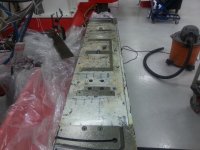I am going to write an ongoing reply as i have some things to do around the house, as the spring weather is something, plus i am headed out of the country on Friday.
I thought I would start with a name product of a material as this is what My Dad and i used when we needed the material as it has a great and long lasting reputation of quality.
http://www.ampcometal.com/documents/datasheets/ampco_alloy_brochure.pdf
We used to rebuild a lot of punch presses in the early days. My Dad especially worked for Huot in Saint Paul who made and still make tool boxes and North Star Steel a big punch press house in Minneapolis. I can recall being in my late teens scraping ball sockets, crank shaft bearings, caps, Rams and hold downs. Back then that's what was used as wear-strips. (more later on why).
On the bearing throws, ball sockets and bearing bushings we bought Amco 8 shaft and for the ways, hold downs and gibs we used Amco 18 plate. In the link i attached they explain the chemical mixtures and what and why it is used for. I don't want to get into that technical stuff as some love to bloviate on that. When we used it we would always rough scrape to 2 to 5 PPI and flat before we epoxy glued it to the ways plus we would drill, tap and countersink holes in it so we would also bolt it on.
Manytimes we were replacing the bronze as it came that way from the new machine builders and wore out. A punch press is a simple machine and the way systems are simple double v's or box ways. The Ram needs to be scraped square to the bottom and aligned to the bolster plate. It is tough and can be machined and scraped. I was just talking yesterday about Timesavers Lapping compound and where I saw it used one time was with a Bliss factory Tech that was working on a large press in the GE Plant in MPLS. The press needed a new crankshaft bearing. We were hired to assist the guy and instead of scraping the bearing and cap to the crank, he mixed up the yellow lapping compound, put on the cap loosely and ran the machine for a while..added some more compound, tightened the cap until it was tight and lapped in the bearing. Then cleaned it, scraped in oil pockets, ground in oil grooves and put it together.
We also used Amco 18 on G&L and Lucus Horizontal Boring Bars saddle ways and gibs, I have also used Nylatron on a Bullard HBB too. One doesn't see Bullard Horizontal Bars to often, but they exist.
The first time I saw Turcite was when I was a contractor at Midwestern Machinery (MWM) in MPLS. My Dad, brother and I were there rebuilding all kinds of machines and using bronze and Phenolic wear-strips. MWM sold a Gleason Curvic coupling grinder to Garrett Aero-Space in Phoenix and I flew down there so they could show me how to install Turcite and scrape it. They were buying new machines from Gleason and installing Turcite on the ways. They explained the reason they did that was because when the original cast iron box ways needed .001" clearance for the oil film to lubricate the ways. But when they indexed the part and the locking pin (lever) engaged the vibration would sometimes move the saddle over the .001" clearance and ruin the curvic coupling they were grinding. I have other instances of using it and Moglice I will share later. Rich









